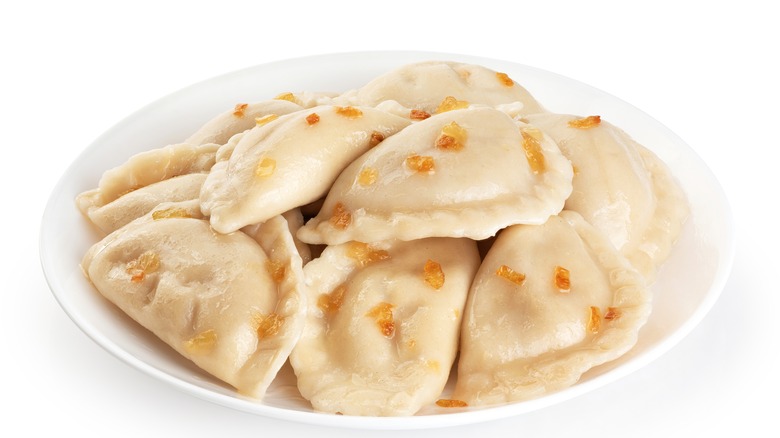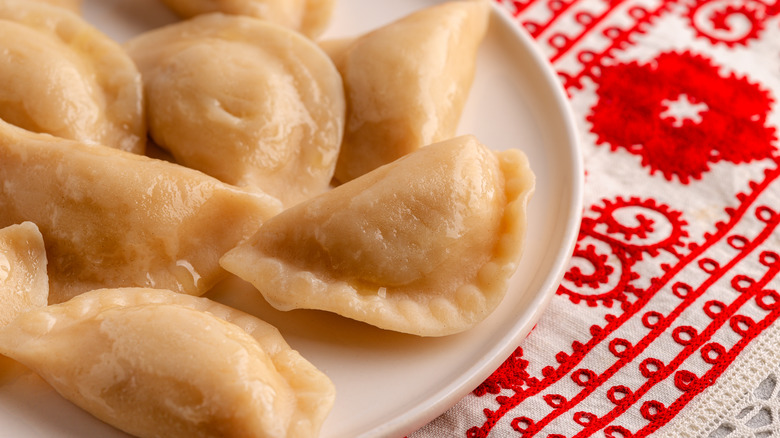Is There Really A Patron Saint Of Pierogi?
If you've never heard of pierogi before, imagine a pasta shell stuffed with mashed potatoes that's been either deep-fried or sautéed in butter. While this may sound like a simple dish, the truth is that pierogi (which is the correct plural, by the way) are a staple of Polish cuisine, not only being an incredibly beloved dish in Europe but also wildly popular in certain parts of the United States. According to Key to Poland, there is a selection of states that form what is known as the "Pierogi Pocket" of America, which consumes two thirds of the total pierogi eaten in the U.S. annually. In fact, one of the nation's most popular pierogi manufacturers, Mrs. T's, is located in Shenandoah, Pennsylvania.
The reason for the pierogi's popularity in the United States is because of Polish immigrants. According to Positively Pittsburgh, Polish migrants to Pennsylvania brought the dish, which was formerly viewed as a type of "peasant food," over with them. Although you can easily walk into any supermarket and grab a box of Mrs. T's or any frozen pierogi out of the freezer aisle, homemade pierogi still remain a critical part of Polish culture in the United States.
But while you may understand the reason for the pierogi's popularity, you probably didn't know about its patron saint. Just who is he and what did he do that made him the patron saint of a dish typically served with butter and onions?
Saint Hyacinth is the patron saint of pierogi
Every skill and occupation has a patron saint, from doctors to carpenters to architects to chefs. But how exactly can there be a patron saint of pierogi? According to The Observer, Saint Hyacinth was born to a wealthy family in Silesia, Poland. Like most children born to aristocrats, Hyacinth went to prestigious schools, and while studying in Rome, he encountered Saint Dominic, who convinced him to join the religious order that would be known as the Dominicans, thus leading to Hyacinth's life in the church. As a Dominican apostle, Hyacinth traveled across Poland and Europe, preaching and establishing priories as he went.
It was during a visit to Kościelec in the year 1238 that the link between Hyacinth and pierogies was formed (via Polish Villa). One story goes that, when a storm destroyed the village crops, Hyacinth lead the people to pray and, in a miracle, the crops flourished the very next day. In gratitude, the townspeople gave Hyacinth a gift of pierogi made from the renewed crops. Another story goes that, following the Tatar invasion, a famine spread across the land. Hyacinth, in this story, is credited with distributing pierogi to the hungry people.
Hyacinth's connection to pierogi is so great that The Observer notes a Polish exclamation related to it: "Swiety Jacek z pierogami!" or "Saint Hyacinth and his pierogi!"
Saint Hyacinth's feast day is August 17
Saint Hyacinth was canonized into sainthood by Pope Clement VIII in 1594 (via Saint Hyacinth's Catholic Church). Nowadays, the patron saint of pierogi and weightlifters (the latter is due to one particular story where Hyacinth was able to carry a massive statue of the Virgin Mary with ease, according to Fringe Sport) has a feast day of August 17. He's still remembered through many parishes across the United States.
Today, Saint Hyacinth's supposed invention, the pierogi, continues to be an incredibly popular dish enjoyed by many Americans, Polish or not, in astounding numbers. Cleveland.com tells us that the markets of Cleveland and Akron, Ohio consume 850,000 pounds of these dumplings every year, with 31 million pierogies being consumed annually across the United States. Every October 8 is National Pierogi Day, and at Mrs. T's in Shenandoah, PA, the festivities include an annual community picnic with games, events, and lots of Polish foods (via Skook News).
Whether you're frying up some frozen pierogi or you're a fan of making your own, maybe send up a prayer to Saint Hyacinth to make that Polish dumpling a little extra special. You could also enjoy other Polish cuisine like pączki or kapusta.


